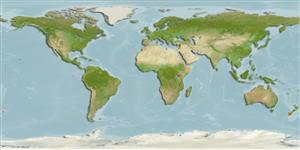Cheilopallene trappa Clark, 1972
| Native range | All suitable habitat | Point map | Year 2050 |

|
| This map was computer-generated and has not yet been reviewed. |
| Cheilopallene trappa AquaMaps Data sources: GBIF OBIS |
Upload your photos
Google image |
No photo available for this species.No drawings available for Callipallenidae.
Google image |
No photo available for this species.
Classification / Names Common names | Synonyms | CoL | ITIS | WoRMS
Pycnogonida | Pantopoda | Callipallenidae
Environment: milieu / climate zone / depth range / distribution range Ecology
Benthic; depth range 0 - 81 m (Ref. 9). Temperate
Distribution Countries | FAO areas | Ecosystems | Occurrences | Introductions
Southwest Pacific: New Zealand.
Length at first maturity / Size / Weight / Age
Maturity: Lm ? range ? - ? cm
Short description Morphology
Trunk, short, compact, fully segmented, with 3 -4 short dorsomedian setae. Lateral processes short, closely spaced, glabrous. Neck very short, ocular tubercle at narrowest part, dorsal to oviger implants, with large prominent eyes. Proboscis bottle-shaped, broadest at base, tapering to ovoid shape with moderately long distal tubular area. Lips, narrow flat in adults, tripartite and splayed apart in juveniles, without distal setae field. Abdomen short, not as long as tip of first coxae of fourth leg pair. Chelifores massive, scapes, short, with single median and few short distal setae. Chelae with large triangular palm, short fingers. Immovable finger with rounded end tubercle, of immovable finger, with few short ectal setae. Palps lacking. Ovigers with long fifth segment bearing a laterodistal apophysis with several short spines. Strigilis segments short, with typical spines, terminal claw shorter than terminal segment, with 3 - 4 short endal teeth. Legs moderately long, with rows of short spines on both tibiae, some associated with low tubercles. Tarsus short, with one stout sole spine. Propodus short, well curved, with 3 larger heel spines and 5 - 6 smaller sole spines. Claw robust, well curved, long in relation to propodal length. Without auxiliaries. Female slightly larger, neck and proboscis longer than those of male. Ovigers without fifth segment apophysis, shorter (Ref. 9).
Snares Islands, south of Stewart Island, from low water to 81 m (Ref. 9).
Life cycle and mating behavior Maturity | Reproduction | Spawning | Eggs | Fecundity | Larvae
Members of the class Pycnogonida are gonochoric and sexually dimorphic. During copulation, male usually suspends itself beneath the female. Fertilization occurs as the eggs leave the female's ovigers. Males brood the egg masses until they hatch. Life cycle: Eggs hatch into protonymphon larva then to adults.
Main reference
References | Coordinator | Collaborators
Child, C.A. 1998. (Ref. 9)
IUCN Red List Status (Ref. 130435)
CITES status (Ref. 108899)
Not Evaluated
CMS (Ref. 116361)
Not Evaluated
Threat to humans
Human uses
| FishSource |
Tools
More information
Internet sources
BHL | BOLD Systems | CISTI | DiscoverLife | FAO(Publication : search) | Fishipedia | GenBank (genome, nucleotide) | GloBI | Gomexsi | Google Books | Google Scholar | Google | PubMed | Tree of Life | Wikipedia (Go, Search) | Zoological Record
Estimates based on models
Preferred temperature
(Ref. 115969): 10.4 - 15.5, mean 11.9 (based on 12 cells).
Price category
(Ref. 80766):
Unknown.


